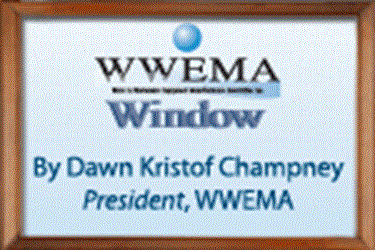WWEMA Window: Smart Procurement — Investing More To Pay Less

By Dawn Kristof Champney, President, Water and Wastewater Equipment Manufacturers Association
We are taught early on that changing your car’s oil on a regular basis is one of the best investments you can make to keep it running well, avoid costly engine failure, and achieve its life expectancy. Thank goodness today’s cars come equipped with a nice indicator light reminding me of when the next checkup is due.
Our nation’s water infrastructure has similar indicator lights, which if left ignored can result in enormous costs to communities — 700 daily water main breaks being among them. The increasing frequency of these incidents means the nation’s nearly 200,000 water systems, treatment plants, and sewer collection systems are no longer “out of sight and out of mind,” and in some ways, that is a good thing as they bring to light the enormous investments that need to be made to fix our deteriorating water infrastructure.
Two newly published reports make the case that we need to do things differently in regard to our approach to water infrastructure investments. The U.S. Conference of Mayors Water Council has issued a report titled, Municipal Procurement: Procurement Process Improvements Yield Cost-Effective Public Benefits, focusing on the shortcomings of traditional procurement practices. And the National Taxpayers Union has produced a similar report, Reforming Our Nation’s Approach to the Infrastructure Crisis: How Competition, Oversight, and Innovation Can Lower Water and Sewer Rates in the U.S.
While each targets the selection of pipe material as an example of how utilities can ultimately save money, both emphasize the need to get away from the low-bid mentality that has plagued our industry and focus instead on the life-cycle cost of any product being procured. As stated in the latter report:
“The life-cycle cost of a pipe is not the initial purchase and installation price, but the value received through the pipe asset from cradle to grave.”
It goes on further to state that:
“Innovation occurs when life-cycle costing is incorporated to reduce the exposure to unexpected future liabilities.”
WWEMA has been a major advocate of life-cycle costing as part of its push for value-based procurement, knowing that innovation will advance only if there is a willingness to invest in new technologies, or improvements to existing technologies, that offer long-term savings to the end user. In fact, WWEMA collaborated with the National Association of Clean Water Agencies back in 2000 to publish a report titled, Optimizing Public Agency Purchasing Power, which references nine distinct procurement methods available to local governments and “elements of value” that should be considered when making purchases. In it, we noted that:
“By examining the wide array of current procurement policies, procedures, laws and regulations, and focusing on value, municipal purchasing officials can — in partnership with other municipal officials, leaders, and stakeholders — maximize public purchasing power to enable the utility to improve efficiency, increase competitiveness, and protect the public interest.”
We also published the results of a survey of procurement methods allowed by each state when utilizing Clean Water State Revolving Funds, to further illuminate the various procurement options available to municipalities to ensure that they get the best return on their investments. We were pleased to note that both Optimizing Public Agency Purchasing Power and the WWEMA survey of states were cited heavily within the U.S. Conference of Mayors report.
Hopefully, by investing a little more time upfront during the design stage and using these resources in the procurement process, municipal officials will be better equipped to carry out their fiduciary responsibility and safeguard public dollars by obtaining the best value in their purchasing decisions.
